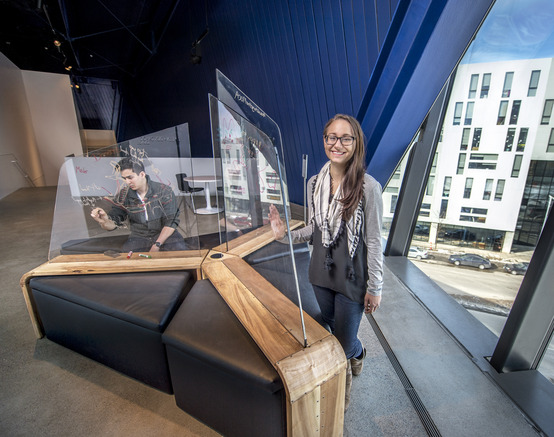
News . Feature Stories . Furniture design competition brings student work to MOCA Cleveland
News
February 11, 2015
Furniture design competition brings student work to MOCA Cleveland
Two student-designed furnishings already generating buzz; another on the way

By Cindi Deutschman-Ruiz
The Museum of Contemporary Art Cleveland needs furniture that’s as contemporary and compelling as its architecturally stunning new building. So MOCA turned to CIA’s Industrial Design Department for ideas. As a result, CIA and MOCA now co-sponsor an annual furniture design competition that has already netted two museum-worthy pieces for MOCA’s first-floor Gund Commons.
Last month at MOCA, CIA senior Katelyn Petronick saw her winning submission unveiled.
“I expected people to go up and use the Ignite at the unveiling, but I didn’t expect the swarm of excited people drawing and playing with the panels. The overwhelming excitement of the interactions was thrilling,” Petronick said.
And her piece is well named. She titled her piece Ignite for the relationships she thought it could spark from positive interactions as people sit on its seats and draw on its panels.
At around the same time her piece was made available to museum visitors, students participating in this year’s furniture design competition presented their own concepts at MOCA. Selection of the 2015 winner should happen by mid-March, according to MOCA’s Deputy Director of Program, Planning and Engagement Megan Lykins Reich.
The chosen piece will require refinement and manufacturing before it too is installed at the museum, months from now.
This collaboration between MOCA and CIA dates back to 2012, said Reich, when “MOCA recognized an opportunity to engage the Industrial Design department at CIA in a new relationship that would enhance our institutional partnership, leverage the incredible skill and creativity of their students and faculty, provide innovative, high-quality, one-of-a-kind design solutions for our building, and generate deeper audience interest in the relationship of contemporary art and design.”
The initial selection was designed by then-senior CIA student Dave Pickett ’12. Pickett’s Floorscape is a large, multi-use lounge piece, comprising interlocking cushions that sit low to the ground on a metal frame.
Reich said that Floorscape created “an interesting dialogue with the architecture” of the museum, and has become very popular, “a favorite gathering place for kids and teens.”
Since Pickett’s piece went up in 2012, the CIA/MOCA partnership has evolved into the competition involving junior Industrial Design majors. Each year, MOCA sets the parameters for the competition.
As Industrial Design Chair Dan Cuffaro explained, students who choose to participate develop prototypes to present to MOCA. Either one design is chosen outright, or several are considered for further development, he says. When a piece is ultimately chosen, students build it on their own, or they collaborate with a fabricator to transform their prototype into a final piece.
Cuffaro said that when MOCA first approached CIA with the idea, he immediately saw the value in the partnership.
“MoMA, The Museum of Modern Art in New York City, has an impressive design collection, and it is a major accomplishment to have a piece in that collection. The idea that our equivalent is willing to commission and exhibit a piece created by my students speaks to MOCA’s desire to be accessible, and presents an amazing opportunity for our students,” Cuffaro said.
“As an experience and accomplishment for a student, this is very valuable. It was a no-brainer for me to encourage the collaboration,” he added.
MOCA’s prompt for last year’s competition—the one that Petronick won— was “to create a piece of furniture which would create more traffic and bring life to the [ground floor] space,” according to Petronick.
“For me this included storage, due to the fact that the museum has limited storage space, functionality for both an average day and special events, and most importantly how it can aid in social interaction. I pulled a lot of inspiration for the form from MOCA’s architecture, pulling in elements that I felt would make it both dynamic and at home in the space.”
Her final piece, Petronick said, allowed for people not only to interact but also to have some privacy, if desired. “I felt that if I seated them in a way that they would feel exposed, they would opt to sit elsewhere and void out any chance of a new interaction. That led me to my final design which created space dividers that doubled as the space for interaction.”
The development process was perhaps the richest learning experience for Petronick, who said that the months leading up to the recent unveiling were “filled with firsts for me. I had to learn to budget, network, find reputable contractors, be willing to make changes and let things go. I think that overall I learned that the design process never really ends.”
To Reich, Petronick’s piece is particularly noteworthy in that it “can be deconstructed to provide other seated options... The soft-seating nests in the screen structure, but it can also be brought out to use elsewhere. This flexibility was very shrewd, and useful to us.”
Reich added that “the variance in materials—glass, leather, wood—gives an alluring visual tension. The glass sails directly reference the many glass walls in the gallery, but perform uniquely in ways that have opened our eyes to the potential of the glass walls elsewhere. In total, Ignite is an incredibly thoughtful, practical and dynamic furnishing that functions simultaneously as a sculpture, a couch and a drawing board.”
“We are very pleased,” Reich said.
Cindi Deutschman-Ruiz is a freelance writer/editor and instructor of journalism and mass communication. She lives on the West Side of Cleveland.
Latest Headlines view all
-
April 24, 2024
Cleveland Institute of Art welcomes alum Omari Souza as 2024 Commencement speaker -
April 02, 2024
Cleveland Institute of Art students partner with Progressive Art Collection to exhibit Ready, Set, Relay! -
March 04, 2024
Cleveland Institute of Art announces Curlee Raven Holton Inclusion Scholar Program
Questions?
For more information about this or other CIA news, contact us here.
Social Feed